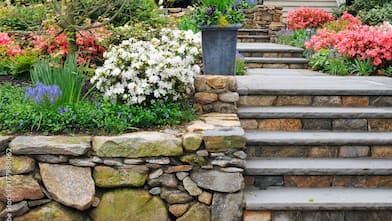Give your backyard a major glow-up by adding pavers to your hardscape
There’s no doubt that spending time outdoors in your backyard paradise is a fantastic way to enjoy your downtime. But in the heat of summer, that cement slab patio is probably a little uncomfortable, not to mention glaringly bright when the sun’s rays are shining on it.
To give your backyard paradise a major glow-up, consider adding pavers. The benefits of pavers include not only helping to beautify a space but also cutting down on maintenance, giving you more time to enjoy outdoor living and less time maintaining it.
What Are Pavers?
Pavers, also called paving stones, are shaped stones made of brick, cement, or natural stone that are used as flooring in outdoor spaces. Pavers can be added to driveways, walkways, pool decks, patios, and fire pit surrounds.
Benefits of Upgrading to Pavers
There are many benefits to upgrading your outdoor spaces with pavers, both aesthetically and economically.
Pavers increase your property value by up to a 70% return on investment.
Pavers beautify outdoor spaces. A pathway to your garden or a patterned patio will increase visual appeal and break up the monotony of a lawn space.
Pavers are easier to maintain than wood decks. There’s no need to worry about staining and sealing wood every few years and, unlike wood, there’s no need to worry about replacing rotten deck boards.
Pavers are more durable than cement slabs. Pavers won't crack or shift like a slab patio and if one paver cracks, you can replace it, and not have to redo the entire space like with a slab.
Paver patios and driveways can last well over 50 years if they’re installed properly.
Pavers are easy to maintain and inexpensive to repair.
How Do Pavers Compare to Cement Slabs?
The most commonly used materials in outdoor spaces are cement and wood, and both come with unique drawbacks compared to pavers. What’s the difference between pavers and cement slabs? Cement is prone to mildew and mold, discoloration, and cracking from frost heave and water seepage.
Repairing cement cracks can be both costly and time-consuming and if done incorrectly, cracks will continue. Though cement slabs are inexpensive on the front end, their upkeep and repair over the long term make them a costly option for outdoor spaces.
How Do Pavers Compare to Wood Decks?
Wooden decks and patios are commonplace throughout the country and though they offer high visual appeal, the upkeep they require is taxing both physically and financially. Staining or painting your wooden deck is required every few years to prevent boards from becoming water damaged and rotting.
If rot does occur, entire sections of decking must be replaced. If rot becomes widespread, it could pose a physical danger to you and your family.
What Types of Pavers Are Available?
.jpeg?impolicy=leadImage)
There are many types, styles, and benefits of pavers available for residential use. Pavers come in different colors and shapes and can be made from different materials to create striking color and texture combinations. The kinds of pavers you choose depend on your intended use and personal taste.
Natural Stone Pavers
Natural stone is mined from the Earth, so each paver has a unique look and pattern. This type of paver withstands the elements well and adds a timeless look to outdoor spaces, often gaining more character as it ages. Natural stone pavers are easy to maintain, only requiring regular sweeping and occasional spraying with a hose to remove debris.
There are many types of natural stone pavers and each will bring a different aesthetic to your backyard paradise. Whether you’re going for a natural look that mimics the great outdoors, a posch space for hosting outdoor dinner parties, or a comfy sitting area to enjoy a fire pit, you can find a stone to match your dream.
When exploring options for natural stone pavers you can choose from the following types of stone:
Granite
Bluestone
Flagstone
Limestone
Travertine
Marble
Sandstone
Slate
Cement Pavers
These pavers are made from cement that is placed into molds, shaped, and dried. Dyes can be added and patterned to mimic natural stone and textures and other finishes may be added to increase aesthetic appeal.
Cement pavers are more durable than cement slabs individually and as a whole due to the fact that they are separated by thin grooves filled with sand that allow for flexibility and the slight changes in size caused by seasonal temperature fluctuations. Cement pavers can be placed in a variety of patterns to create visual appeal in outdoor spaces.
Clay Pavers
Clay pavers, which are also called brick pavers, are created from a variety of clays that are high-fired in a kiln, producing tough, resilient, and durable paving stones. Depending on the types of clay used, these pavers can be found in shades from brick red and orange terracotta to pale creams and whites.
Since they are created using natural clays and not dyes, the colors do not fade over time with exposure to the elements and UV radiation from the sun.
Porcelain
Porcelain is another popular type of clay paver with its own benefits. Made of finer clay than brick pavers, porcelain is also high-fired in a kiln. These pavers are durable despite being made of porcelain, which is traditionally thought of as a fragile material. They are water- and oil-resistant when properly sealed, making them ideal for outdoor spaces, and they can hold up for decades with minimal care and maintenance.


.jpeg?impolicy=leadImage)


